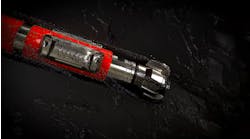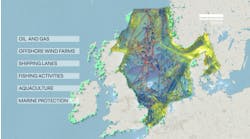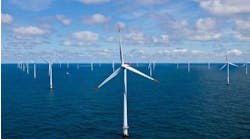Compared to the traditional mooring components, the radically different char-acteristics of the new fiber ropes represent a potent tool for the designer and widen the range of available solutions to mooring problems. For the designer of deepwater mooring systems, the immediate att-ractions are their low weights and axial stiffness.
In the sense of short term (extreme) response (ULS) of a system, these properties can easily be translated by the designers into reduced excursions of a floater and reduced vertical loads due to the mooring system. Predictions of the long term (fatigue) characteristics (FLS) are less obvious and usually require more time consuming and complex calculations. Driven by practicality rather than logic, this is reflected in the industry design practice in which designs usually are made on the sole basis of extreme response. Thus, leaving fatigue capacity as a final stage documentation task.
In relation to deepwater moorings, the design practice becomes more important as systems are likely to be taut with highly pretensioned lines. The high pretension level reduces, or in the case of fiber ropes, eliminates compliance due to the weight and geometry driven catenary deformation. Thus, the line will be operating in an axial mode largely governed by its axial stiffness properties. The result is wave frequency tensions and efficient load transfer throughout the length of the lines, which both are factors normally expected to have adverse effect on fatigue.
Generally accepted as having good fatigue properties, the ropes themselves may not be a concern. However, for any connecting components, typically chains and shackles, experience from traditional shallow water moorings readily shows fatigue capacity to be marginal or even the limiting factor in design.
This concern equally affects fiber and steel wire rope systems. However, in the case of fiber ropes, the uncertainties associated with the physical properties, in particular the axial stiffness, represent an additional concern. The insignificant weights of the fiber ropes lead to a pure axial mode of operation, with the axial stiffness as the key parameter describing the behavior of the line.
Design practices
On this background, questions can be raised both regarding the adequacy of the existing design practice and concerning the nature and criticality of fatigue in the new taut moorings. In an attempt to address this, a limited study was launched early this year focusing on a comparison between fiber and steel wire ropes in deepwater moorings accounting for both extreme response and fatigue.
Two alternative rope types were applied as the main component in a range of systems covering various degrees of lateral stiffness. The aim of the study was to investigate the fatigue characteristics of taut moorings, the correspondence of these characteristics to extreme response criteria, and establish any general design implications of fiber versus steel wire rope.
The study focused on taut mooring systems for a unit at 2000 meters water depth in typical Gulf of Mexico environmental conditions. The unit was taken as a typical turret moored monohull floating production, storage, and offloading (FPSO) vessel, with an overall length of 800-900 ft, for which a 12-point symmetric spread of equal internal angle was assumed.
The study further concentrated on spiral strand construction steel wire rope and polyester rope as the two alternative components. The latest information on Superline polyester ropes was obtained from Marlow Ropes, while spiral strand steel wire rope data were based on information from ScanRope and TrefilEurope. Vicinay Cadenas and DNV MOU were used as sources for data on offshore chains. To be in line with typical class society requirements for fiber ropes, a 10% margin on polyester rope strength was introduced.
Regarding line design, inclined simple catenary configurations were assumed. For both polyester or steel, both line types included top and bottom chains. At the top end, this was to incorporate the usual requirements for winching. At the bottom, this reflects the typical requirements for ensuring seabed clearance of ropes, in particular fiber ropes for which any contact with seabed particles is critical.
Given the generally accepted superior fatigue characteristics of both steel wire and polyester ropes when compared to other mooring components, such as offshore chain, the focus of the study is on the fatigue damage inflicted on the top and bottom chain components. Consequently, the same S-N data were applied to both spiral strand and polyester systems, allowing direct comparison of the fatigue damage in the lines themselves. For the polyester systems, variations in axial stiffness are included as an additional exercise accounting for the uncertainties in determining this parameter.
Methodology
The design and analysis methodology adopted was based on the procedures outlined by API and DNV. Using frequency domain dynamic approach, a range of systems were designed covering a range of lateral stiffness levels. To allow direct comparison between systems, the designs were made with equal extreme response safety level (minimum factor of safety).
For the total of 15 systems considered in the study, a variation within +3% in safety level was achieved. The variable was considered acceptable for comparison purposes of this study. Frequ-ency domain fatigue analysis was performed to determine the tension variations in the systems (low and wave frequency RMS line tensions). This analysis resulted a set of environmental conditions and associated probability levels used to describe a typical US Gulf of Mexico loads during a 25-year design life. Fatigue damage, and thus fatigue life, is derived using the dual narrow band DNB method, as described in the DNV Position Mooring draft code (OS-E301).
The non-linear stiffness characteristics of the polyester ropes are handled both in frequency and load plane. In the load plane, this simply involves discretizing the load extension curve used by the catenary equation into small linear sections. In the frequency plane, where axial stiffness is assumed to vary according to the frequency of excitation, the method becomes more complicated and affects the procedure of the analysis. Here, the standard analysis approach is amended by separate analysis of the low and wave frequency dynamic components.
In principle, axial stiffness behavior is linearized for two load regimes: (1) load dependant drift stiffness for the static and low frequency regime and (2) load dependant storm stiffness for the wave frequency regime. As the mooring system stiffness does not affect the wave frequency motion calculation, vessel excursions can be derived using the drift stiffness of the ropes.
As direct addition of offset/excursion components cannot be made, the reaction force is instead used to obtain the correct static load prior to dynamic analysis. For the dynamic analysis, the storm stiffness is applied to the ropes and the pretension level set to the nominal value thus maintaining the same distribution of tension within the system.
Results
Key properties of the various systems showing the combined effect of taut lines and lightweight ropes resulting in minimal catenary effects and thus a more direct transfer of loads along the line. This is reflected in the fatigue analyses where both wave and low frequency tension ranges generally are found to be fairly constant along the length of the line.
Comparing fatigue of the two types of systems, the main difference is found in the low frequency band. This is largely explained by the difference in system natural period, which governs the low frequency fatigue. In addition, consistent with their light weight, low frequency tension variations for polyester systems are seen to be slightly larger especially for the intermediate seastates that contribute most to fatigue.
This is shown as slightly lower fatigue lives for polyester rope systems. Further, plots of the fatigue lives resulting from +20% variation in axial stiffness are included, showing the significance of this parameter. Generally, the fatigue life curves show a sagging profile. This is attributed to the combined effect of pretension and configuration of bottom chain.
In tauter systems, high pretension results in an even distribution of tensions between the lines and thus smaller tension variations affecting a larger number of lines in the spread. The taut configuration of the bottom chain is maintained with little variation in grounded length.
Conversely, in softer systems, lower pretension leads to concentration of tensions on a smaller number of lines in the spread and consequently large tension variations in these lines, while the remainder are less influenced. The bottom chain operates as a compliant catenary. For systems in between, the bottom chain is subjected to large dynamic variations in grounded length, causing an increase in low frequency damage.
Being a study of limited resources, systems presented here are designed manually, aiming at optimum performance. No use has been made of design optimization tools. However, the simple line configurations involved do not give rise to significant uncertainties related to the designs themselves.
Also, the number of systems considered (15) are limited. However, based on the extensive iterations during design, it is considered that a good representation over the useful range of application is achieved. In view of this, the study allows the following main conclusions:
- The useful range of pure catenary application of polyester ropes and steel wire ropes lies within separate excursion ranges with the following approximate limits: 2-5% for polyester systems; 10% and onwards for steel wire rope systems.
- Steel wire rope in a simple catenary is acceptable for deepwater applications and "rough sea" conditions. The prerequisite for this is that max excursion levels in the order of 10% of water depth are acceptable as are the vertical loads involved. For stiffer systems, different solutions are called for using polyester ropes or introducing buoy assistance to the steel wire ropes.
- Fatigue capacities of both types of systems are found to be marginal in relation to typical fatigue criteria. This highlights the importance of addressing fatigue in the design phase.
- Steel wire rope and polyester systems are found to have the same level of fatigue damage in the critical components (top and bottom chains). Indications are that steel wire rope systems inflict slightly less fatigue damage mainly due to shorter natural (low frequency) periods.
- Variation in axial stiffness of the polyester ropes has a significant impact on estimated fatigue life, while only little effect is found for extreme response. Following an axial stiffness variation of +20%, the study shows -30% to +60% change in fatigue life, while variation in, respectively, excursions and tensions remained within +10% and +3%. This shows that the uncertainties related to the definition of this parameter are critical in design and should be addressed by sensitivity checks.
- Bottom chains in a taut line generate tension variations, and thus fatigue damage. The magnitude of the damage is found to be sensitive to the bottom chain configuration controlled by its length and line pretension. Being either taut (about zero grounded length) or inactive (largely grounded on the seabed), less fatigue damage was found compared to the intermediate conditions with significant dynamic changes in grounded lengths.
The overall conclusion from the study remains that deepwater taut moorings are potentially associated with marginal fatigue capacities and thus call for a more complete design procedure, where extreme response and fatigue is considered in parallel rather than in series.
Further, when such systems comprise fiber ropes, the resilience of the design subject to uncertainties in rope properties needs to be addressed during design. Finally, given the obvious design limitations, steel wire rope moorings remain an alternative for water depths up to 2,000 m and rough sea conditions.











